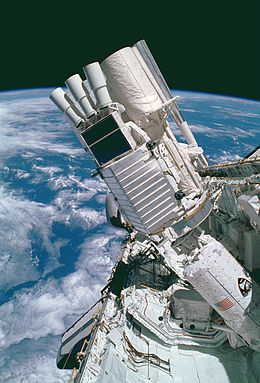STS-35

The ASTRO-E payload deployed in Columbia's payload bay
|
|
| Mission type | Astronomy |
|---|---|
| Operator | NASA |
| COSPAR ID | 1990-106A |
| SATCAT no. | 20980 |
| Mission duration | 8 days, 23 hours, 5 minutes, 8 seconds |
| Distance travelled | 6,000,658 kilometers (3,728,636 mi) |
| Orbits completed | 144 |
| Spacecraft properties | |
| Spacecraft | Space Shuttle Columbia |
| Launch mass | 121,344 kilograms (267,518 lb) |
| Landing mass | 102,462 kilograms (225,890 lb) |
| Payload mass | 12,095 kilograms (26,665 lb) |
| Crew | |
| Crew size | 7 |
| Members |
Vance D. Brand Guy S. Gardner Jeffrey A. Hoffman John M. Lounge Robert A. Parker Samuel T. Durrance Ronald A. Parise |
| Start of mission | |
| Launch date | 2 December 1990, 06:49:00 UTC |
| Launch site | Kennedy LC-39B |
| End of mission | |
| Landing date | 11 December 1990, 05:54:08 UTC |
| Landing site | Edwards Runway 22 |
| Orbital parameters | |
| Reference system | Geocentric |
| Regime | Low Earth |
| Perigee | 352 kilometres (219 mi) |
| Apogee | 362 kilometres (225 mi) |
| Inclination | 28.45 degrees |
| Period | 91.7 min |
 Left to right - Front row: Gardner, Brand, Lounge; Back row: Parker, Parise, Hoffman, Durrance |
|
STS-35 was the tenth flight of Space Shuttle Columbia, the 38th shuttle flight, and a mission devoted to astronomical observations with ASTRO-1, a Spacelab observatory consisting of four telescopes. The mission launched from Kennedy Space Center in Florida on 2 December 1990.
Prior to the Challenger disaster, this mission was slated to launch in March 1986 as STS-61-E. Jon McBride was originally assigned to command this mission, which would have been his second spaceflight. He chose to retire from NASA in May 1989 and was replaced as mission commander by Vance Brand. In addition, Richard N. Richards (as pilot) and David Leestma (as mission specialist), were replaced by Guy Gardner and Mike Lounge respectively. 59-year-old Brand was the oldest astronaut to fly into space until Story Musgrave, 61 on STS-80 in 1996, and U.S. Senator John Glenn, 77 when he flew on STS-95 in 1998.
The much-delayed ASTRO-1 had originally been manifested to fly on what would have been the next shuttle mission after Challenger's ill-fated STS-51L as STS-61E in March 1986. The mission was remanifested as STS-35 during the long stand-down after the accident with the addition of the Broad-Band X-Ray Telescope (BBXRT-01), and the original ASTRO-1 payload was brought out of storage and recertified for flight.Columbia rolled out to Pad 39A in late April 1990 for a scheduled launch date of 16 May. Following the Flight Readiness Review (FRR), announcement of a firm launch date was delayed to change a faulty freon coolant loop proportional valve in the orbiter's coolant system. At the subsequent Delta FRR, the date was set for 30 May. Launch on 30 May was scrubbed during tanking due to a minor hydrogen leak in the tail service mast on the mobile launcher platform and a major leak in the external tank/orbiter quick disconnect assembly. Hydrogen was also detected in the orbiter's aft compartment and believed to be associated with a leak involving the 17-inch umbilical assembly.
...
Wikipedia

